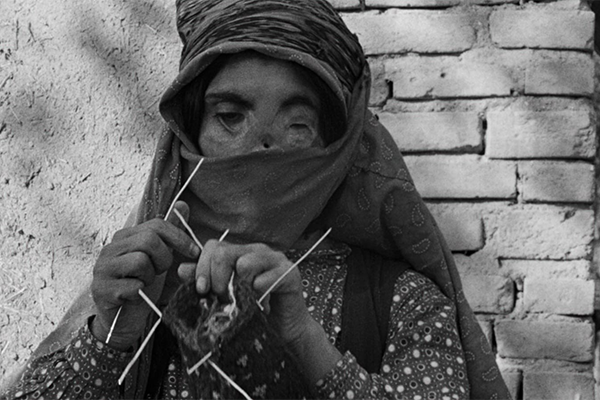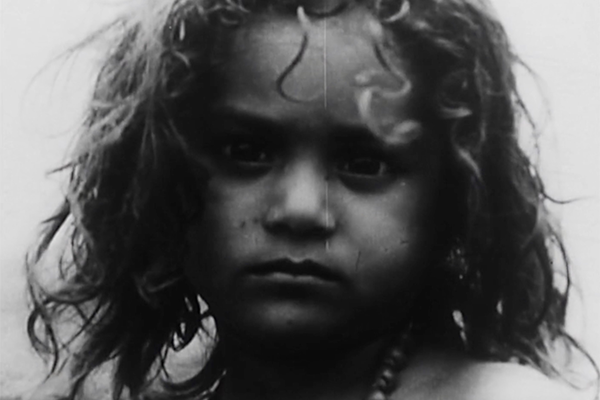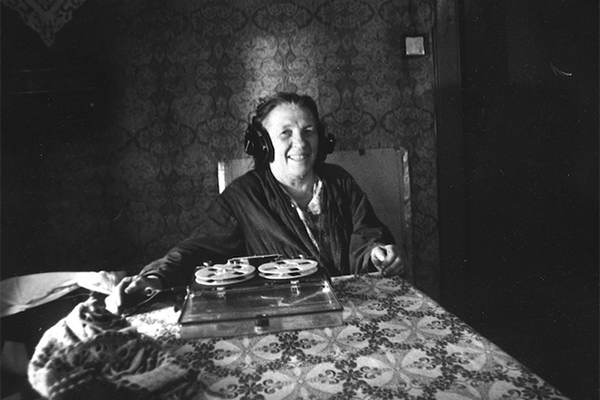This Carte blanche screening brings together documentaries important to its curator, Pirjo Honkasalo. On this page you’ll find information on the films, including Honkasalo’s thoughts on why she chose each of these films specifically for this screening.
Language: Eng Duration: 111 min Age Limit: 16+
-
Thu 6.3.
-
14:30
-
Arthouse Cinema Niagara
-
12,50
-
TH41
- Buy ticket
-
Fri 7.3.
-
20:15
-
Arthouse Cinema Niagara
-
12,50
-
FR67
- Buy ticket
-

Khaneh siah ast
The House Is BlackDirector: Forough FarrokhzadCountry: IranYear: 1962Genre: DocumentaryDuration: 23 minFrom Pirjo Honkasalo:
I’m in Jerusalem. For years I have tutored young filmmakers from southern and eastern Mediterranean countries, Iranians among them. Iranian Firouzeh Khosrovany and I keep rewatching material she has filmed of her family. She’s preparing her film Radiograph of a Family, a documentary depicting a family falling apart due to questions of faith. As the country becomes an Islamic teocracy, the mother turns deeply religious and the father loses his connection to his wife. (The film would go on to win the 2020 IDFA Award in Amsterdam.)
We talk a lot. The depth and wit of her thinking is exceptional. The large number of educated and free-thinking young women in a country so restrictive to women is confusing. Firouzeh wants to speak about Forough Farrokhzad, whose erotic feminist iconoclast poetry once created a scandal among the patriarchal literary elite of Iran.
The House is Black, Forough Farrokhzad’s only film, follows lepers in Tabriz, Iran. Forough Farrokhzad’s voice quotes the Old Testament, the Qur’an and her own poetry. The ruthless, poetic imagery of the film is rooted deep in my mind and my memory.
Forough Farrokhzad was born in Teheran in 1934. She was made to marry at the age of 16. She gave birth to a boy, but the marriage fell apart. Forough Farrokhzad was accused of adultery and lost custody of her son. He never learned that his mother didn’t willfully abandon him. It’s a grief Forough never got a release from, and this grief can be sensed from her eyes in The House is Black.
“To be reborn, first you must break,” she wrote.
The documentary was filmed over the course of 12 days in 1962. After the shoot, Forough Farrokhzad adopted a boy named Hossein, the son of two lepers. Hossein moved into the house of Forough Farrokhzad’s mother.
Forough Farrokhzad passed away in a car accident five years later at the age of 32. The cause of the accident is still unclear and has raised a lot of questions, but official documents state that she swerved to avoid an oncoming school bus and was thrown out of her car.
Through her poetry, Forough Farrokhzad gained a reputation as an independent woman and thinker and a renewer of poetry, but her poems and free way of life also caused a lot of loud disdain. After the 1979 revolution, her entire catalogue was banned.
The House is Black was restored in 2019 and premiered at the Venice Film Festival.
"So when I write, if I keep thinking, oh I'm a woman and I must address feminine issues rather than human issues, then that is a kind of stopping and self-destruction. Because what matters, is to cultivate and nourish one's own positive characteristics until one reaches a level worthy of being a human."
– Forough Farrokhzad -

Menq
WeMeDirector: Artavazd PeleshianCountry: Soviet Union, ArmeniaYear: 1969Genre: DocumentaryDuration: 30 minAge Limit:
From Pirjo Honkasalo:
On January 22nd, I receive an email from film director and researcher Mark Cousins.
Hi Pirjo
Hope all is well with you. I'm sure you know the films of Armenian Artavadz Peleshian, but I just rewatched his stunning 25 min movie WE and it made me think of you.
Very best
Mark
In his well-known 14-hour film Women Make Film, Mark Cousins has uplifted female filmmakers from around the world throughout the history of film. It is an honor to stand among them, humbly, and introduced by Tilda Swinton. Since Mark’s film premiered, we’ve tried arranging a joint masterclass numerous times. It’s always stopped short due to illness, strikes, you name it.
I was happy to hear from Mark, but also amused. I’ve never seen Artavazd Peleshian’s We, though I’ve read of his theories. I watched it immediately. Why did We specifically make Mark think of me?
I decided to choose the film We for my Carte blanche screening at Tampere Film Festival.
Artavazd Peleshian was born in Gyumri, Armenia, on the 22nd of February, 1938 (the same February date as myself). He studied to be a technical illustrator in Vanadzor before continuing his studies at the VGIK film school in Moscow. He’s now 87 years old.
Artavazd Peleshian has developed a theory called montage-at-a-distance, also called ‘contrapuntal montage’. He wanted to break the traditional linear habit of combining details. He calls it perpetual motion, a thing whose individual pieces are meaningless and only the whole matters. When watching a film, one should be consciously aware of its each individual element, even those you can’t currently see or hear.
His theories are also quite cryptic: “A birth without a bearer: imagine a monster that devours the person from whom he came. Or perhaps a process in which some die while ignoring the fact that they are giving birth, while others, while being born, ignore the fact that they kill.”
I doubt I understand any bit of the above, but watching the film We, I’m enthralled, and none of this unquestioning associative triumph of images and sounds is left unclear to me. Through Armenia, the film reflects all of humanity and the process of becoming human. Maybe that’s something we share: I aim for people to watch my films so that they’re also reading them from beginning to end. Only my montages are more internal. -

Belovy
The BelovsBelovin sisaruksetDirector: Viktor KossakovskyCountry: RussiaYear: 1992Genre: DocumentaryDuration: 59 minFrom Pirjo Honkasalo:
I’m well aware that this isn’t an appropriate time to be showing works by Russian directors; not even those who’ve opposed the Chechen war and Russia’s invasion of Ukraine from the very beginning.
It’s for opposing the Chechen war that Viktor Kossakovsky had to flee from Saint Petersburg and move to Berlin. He hasn’t been able to return. Saint Petersburg still has his heart.
We met at an IDFA competition directors’ lunch in 1993. Viktor was young, skinny, shy, and had a rudimentary grasp of the English language. When you spoke to him, he would look down, stroke his knees and smile. He had a solemn sort of mischievousness to him. I liked him and his competition film Belovy. Belovy was Viktor’s first feature-length documentary film. Viktor won the Joris Ivens Award, I did not. Since then our paths have crossed in peculiar ways over the decades. Still, we’re not particularly close.
I wanted to include Belovy in my Carte blanche screening in Tampere. However, no one was able to find a link to the film for me to rewatch it, so my memories of the film are from thirty years ago.
Like myself, Viktor is a videographer, and both of us have done camera work on our films. While still in Saint Petersburg, Viktor became the master of small subjects and small resources. For instance, he filmed an enthralling film from his apartment window, showing the same street being opened again and again from the very same spot. He made a film about his son, who, until he was two years old, grew up in a house where all mirrors were covered. Svyato shows the boy seeing his reflection for the very first time.
Viktor became successful, his demeanour became exuberant, his beard grew, and he started to have an air of Great Russian-ness about him. In his masterclass in Helsinki’s Kunsthalle, he proclaimed that Finns aren’t allowed to make films in Russia. The outrage from Finnish directors was ruthless: Saint Petersburg is a Finnish city! ‘Neva’ is a Finnish word!
I don’t know Viktor well enough to say how success actually changed him. We’ve both been regular directors at IDFA, in juries, in retrospectives, in masterclasses, as winners of the Joris Ivens Award and in the IDFA Academy.
I ran into his shadow in Tokyo in 2009. A Japanese producer had invited four directors from different countries to make their own films in Tokyo with the intention of showing Japan what it means to make creative documentaries. Viktor and I were among those invited. When I got to Tokyo for my preliminary research, my Japanese producer Ryota Kotani let me know that according to Viktor, as a Finn I would have enough money not to need funding for this research. Ryota’s face dropped in horror upon my confusion. Viktor had spent the money promised to me in three weeks; possibly on Japanese plum liqueur. He never finished a film there. I left to drink plum liqueur on our own bill with Miika Pölkki, my right hand man and interpreter. You had to laugh, and heartily. Despite all this, I finished my film ITO in Tokyo.
Viktor started dreaming of grand films. He himself mentions Godfrey Reggio’s film Koyaanisqatsi as his inspiration. In a way, Reggio came up with a good concept: ¡Vivan las Antipodas! With exhilaratingly gorgeous imagery, he observed extreme antipodes – places on Earth that are geographically diametrically opposite to one another – like Shanghai in China and Entre Ríos in Argentina. Though impressive in its visuals, I couldn’t quite find cognitive depth in the film. If I were to be unnecessarily mean, I might call the film itself an excuse to get funding for a trip across the globe. Many disagree: the film received awards in many festivals. With his later films, small-scaled and grandiose alike, Reggio has become a renowned filmmaker.
The founder of IDFA, Ally Derks, left the festival in 2017. She had invited Viktor and I to celebrate 30 years of IDFA as well as her stepping down. As a parting gift, us directors made a playful little movie together. Viktor did his first and I picked up where he left off, not knowing what he had done. It turned out well. And then we sat side by side and listened as Iikka Vehkalahti gave a sharp, wildly associative and funny speech. I will take this opportunity to say that out of all the people I know who have passed, Iikka Vehkalahti is one of the few who are truly irreplaceable, and I’m sure everyone who was in that room that day agrees with me.
So, is it ethically correct to screen films by Russian directors? For his latest film, Architecton, Viktor filmed drone shots of the concrete ruins in Ukraine. To quote Viktor from a Deadline article in 2024: “When you see these ruins, you know from which direction the missiles came, you know who’s guilty.”
